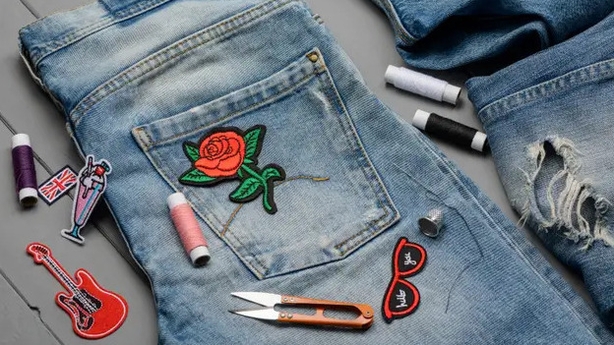Our clothes can suffer a lot of wear and tear, especially those favourite pieces worn day in, day out – whether it’s trusty blue jeans, a timeless black blazer, or a cosy jumper that gets you through chilly months.
Inevitably, garments will (much like their owners) start to show signs of age. But just because a button falls off or stitches come undone, it doesn’t mean you have to say goodbye to your beloved item.
Learning how to make do and mend (as the old saying goes) helps to reduce waste, makes our wardrobes more sustainable, and in most cases it’s a lot cheaper than buying a replacement in the shops.
You don’t even have to own a sewing machine. Here, sewing experts run down six simple fashion fixes you can do yourself…
1. Replace buttons

"Most clothing already comes with extra buttons sewn on the inside – this small repair job is easy and all you need is a needle and thread," says designer and Great British Sewing Bee finalist Raph Dilhan (@raph_sew_and_so).
Layla Sargent, founder and CEO of The Seam, a UK platform that connects people to skilled, specialist makers for alterations and repairs, suggests reattaching a button when it’s loose, to prevent it falling off altogether.
"To avoid stray threads, you can create a looped knot to start your stitching," she explains. "Begin by cutting a length of thread and folding it in half. Thread both ends of the yarn through the eye of the needle and pull them through about 10cm.
"Now, make your first stitch by sewing from the back to the front of the garment and back through again, pulling the needle through the loop of thread to secure itself. We like to use around four loops of stitching through each button hole, but you can also match the look of the other buttons on your garment."
2. Cover holes with patches

While distressed denim may be trendy, Dilhan says a hole or rip in a garment is an opportunity to personalise it by covering it with a patch.
"I use appliques for this. The variety available online is vast, from plain to very colourfully elaborate and in all shapes and sizes," he says. "To attach appliques, just pin it over the hole and then hand stitch the edges in place with regular sewing thread (remember to remove the pins afterwards).
"You can also use a darning thread, which is thicker so the thread itself can become a decorative feature. If you’re not confident to sew an applique on, there are also lots of iron-on patches available."
3. Fix falling hems

If the hem of skirt, dress or pair of trousers starts to come undone, a stitch in time can really help.
"When unravelling happens over a few inches of thread, DIY is a great way to prevent further damage," says Sargent. Try to find a thread that matches the fabric as closely as possible, or go darker if you have to, as that will be less noticeable than a lighter thread.
"Follow the existing stitch line," she continues. "When sewing by hand, shorter stitches, sewn closely together, are the safest way to prevent unravelling and damage in the wash."
4. De-bobble knitwear

This is a useful technique for when you’re digging out your warm clothes ready for autumn and winter.
"When knitted garments and jersey items begin to form little bobbles of fibre on the surface, they can quickly feel worn out," explains Sargent. "A quick garment ‘haircut’ can make a bobbled item feel brand new again."
Be sure to work slowly, and in good lighting, to ensure you don’t accidentally cut through the fabric: "Drape the fabric over the narrow edge of your hand, in a single layer, and use sharp scissors with a wide blade to trim the bobbles one at a time."
She adds: "Knitted garments can be prone to unravelling so ensure you never cut through a piece of yarn – focus on the fibres that have lifted away from the fabric structure."
5. Dye faded fabrics
Not exactly a sewing technique but a handy skill to add to your fashion-fix toolkit.
"If your whites have gone a bit grey or an old favourite shirt has faded, don’t chuck them, dye them instead – you’d be surprised how easy it is to do," says Dilhan. "There are a wide variety of environmentally-friendly machine dyes designed for your pre-loved wardrobe."
Be sure to check the dye is suitable for your fabric (most synthetic textiles won’t work) and follow the instructions to ensure you don’t contaminate your laundry.
Alternatively, experiment with tie-dyeing and other creative methods. Dilhan says: "You can achieve a nice gradient colour with dip-dyeing techniques – great for instance if you have an old dress that needs a new lease of life."
6. Rethread drawstrings

"When the drawstring on a pair of trousers or joggers makes its way outside of the waistband channel, getting it back in place is simpler than it seems," Sargent says.
To start, attach a safety pin to one end of the drawstring. You’ll need a pin that’s narrow enough to fit through the channel, but not the tiny kind you get with garment hang tags.
"Insert the safety pinned end of the string into one end of the channel and inch the fabric along the pin, occasionally distributing all of the gathers along the string, until you’re able to pull the pin out the other side and even the material along the drawstring."

